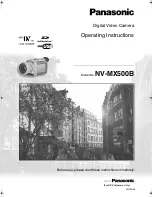
CAMERA COMPOSITION
When describing camera angles, or creating them yourself, you have to think about three important factors:
The FRAMING or the LENGTH of shot
The ANGLE of the shot
If there is any MOVEMENT involved
When describing different cinematic shots, different terms are used to indicate the amount of subject
matter contained within a frame, how far away the camera is from the subject, and the perspective of
the viewer. Each different shot has a different purpose and effect.
CAMERA FRAMING
SONY PDX10 Handbook page 15
1. Extreme Long Shot-XLS
Generally used as a scene-setting, establishing
shot, normally showing an EXTERIOR, eg
the outside of a building, or a landscape.
2. Long Shot-LS
This category includes the
FULL SHOT showing the
entire human body, with the
head near the top of the frame
and the feet near the bottom.
3. Medium Shots-MS
Contains a figure from the waist up and is normally used
for dialogue scenes, or to show some detail of action.
TWO SHOT
(two figures from the
waist up) and the
THREE SHOT (3 fig-
ures from waist up)-any
more than three figures
and the shot tends to
become a long shot.
OVER-THE-SHOULDER-SHOTS
Positions
the
camera
behind one
figure,
revealing
the other
figure, and
part of the
first figure's back, head and shoulder.
4. Medium Close-up- MCU
In between the Close-Up and Medium shots this frame is general-
ly a “bust” shot. Works well for getting in close without the inten-
sity of a close-up.
Variations on the Medium Shot:
Summary of Contents for PDX10 - DVCAM
Page 24: ...SONY PDX10 Handbook page 24 ...
















































